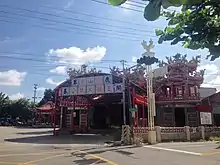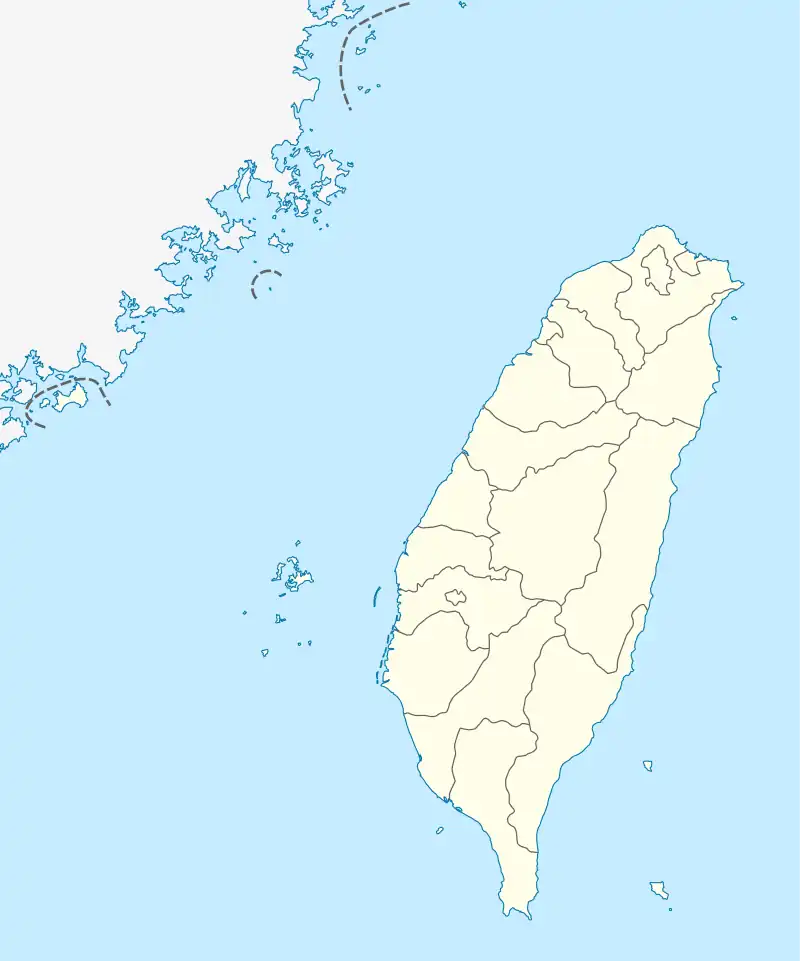| Yuanshan Temple | |
|---|---|
圓山宮 | |
 | |
| Religion | |
| Affiliation | Taoism |
| Deity | Wangsun Dashi |
| Location | |
| Location | Lucao, Chiayi County |
| Country | Taiwan |
 Shown within Taiwan | |
| Geographic coordinates | 23°24′48″N 120°18′22″E / 23.41333°N 120.30611°E |
| Architecture | |
| Completed | 1738 or 1752 |
| Specifications | |
| Direction of façade | East |
| Height (max) | 1.5 m (4 ft 11 in) |
Yuanshan Temple (Chinese: 圓山宮; pinyin: Yuánshān Gōng) is a temple in Lucao Township, Chiayi County, Taiwan. The temple is dedicated to Wangsun Dashi, a legendary child dating back to the Song Dynasty.
History
According to legend, Wangsun Dashi (Chinese: 王孫大使) was a child named Xie Shengxian (Chinese: 謝聖賢) that lived during the Song Dynasty. When he was thirteen years old, Xie traveled Tong'an, Fujian with his dog and lived in the home of a government official with the surname Chen. One day, the official's daughter was possessed by a river snail yaoguai, so Xie sacrificed himself by jumping into a lake next to Feng Mountain (鳳山). Therefore, the Chen clan deified Xie as Wangsun Dashi and built a temple for him next to the mountain.[1]
The Chen clan migrated across the Taiwan Strait in the Qing Dynasty, and brought Wangsun Dashi with them as their protector deity. The clan founded Yuanshan Temple in 1738[2] or 1752[1] to worship Wangsun Dashi in Lucao, and the temple became the religious center of the region. The temple has been rebuilt multiple times, the most recent of which completed in 1976.[1][2]
Architecture
Yuanshan Temple is located within downtown Lucao, facing east. The main altar houses Wangsun Dashi, while the side altars house Fude Zhengshen and Wangsun Dashi's dog. The columns of the temple are carved with antithetical couplets, and each line begins with the characters yuan and shan, respectively, except for the columns beside the side altars.[1][3] Wangsun Dashi's statue is carved with dimples to resemble a boy.[4]
Traditions
Geshuihuo
Every twelve years, Yuanshan Temple holds a ceremony known as geshuihuo (割水火) on the banks of the Puzi River to symbolically call on wandering spirits to change their ways and assemble into an army under Wangsun Dashi. During the ceremony, a temporary altar is placed on a sand bar, and a flag is placed next to the river. Twelve days later, a procession carries weapons and crosses the river to retrieve the altar and the flag, marking the end of the ceremony.[5]
Fanghuoma
Historically, Yuanshan Temple has held a ritual known as fanghuoma (放火馬), where paper horses are paraded around and burned, to protect citizens from disease. However, this ritual was not held for roughly 60 years until February 2021, where it was revived for the COVID-19 pandemic.[6]
See also
- Fengtian Temple, Xingang Township
- Gangkou Temple, Dongshi Township
- Peitian Temple, Puzi City
- List of temples in Taiwan
References
- 1 2 3 4 嘉義縣志.卷十.文學志 (in Chinese (Taiwan)). Taibao, Chiayi County: 嘉義縣政府. December 2009. pp. 124–125. ISBN 9789860208108. Retrieved November 16, 2021.
- 1 2 嘉義縣志.卷九.宗教志 (in Chinese (Taiwan)). Taibao, Chiayi County: 嘉義縣政府. December 2009. pp. 326–327. ISBN 9789860208092. Retrieved November 16, 2021.
- ↑ "圓山宮". Cultural Resources Geographic Information System (in Chinese (Taiwan)). Academia Sinica. Retrieved November 16, 2021.
- ↑ "鹿草圓山宮謝府元帥 宋代敕封王孫大使". Now News (in Chinese (Taiwan)). June 24, 2019. Retrieved November 16, 2021.
- ↑ 吳世聰 (October 8, 2012). "罕見「割水火」 12年1次招兵買馬". Liberty Times (in Chinese (Taiwan)). Chiayi County. Retrieved November 16, 2021.
- ↑ 林宜樟 (February 26, 2021). "暌違近60年!嘉義鹿草圓山宮 放火馬震撼登場". Liberty Times (in Chinese (Taiwan)). Retrieved November 16, 2021.